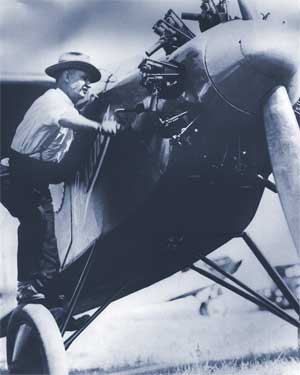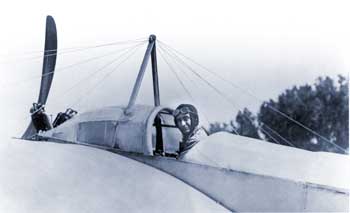|
|
 |
| SW Aviator Magazine is available in print free at FBOs and aviation-related businesses throughout the Southwest or by subscription. |

|
 |

|
 |
 |
 |
|
The web's most comprehensive database of Southwest area aviation events.
|

|
 |

|
 |
|
Featured Site:
|
|
|
 |
|
A continuosly changing collection of links to our favorite aviation related web sites.
|

|
 |

|
 |
 |
|

|
Clyde Cessna
|
Story by Jay Wischkaemper
One can hardly broach the topic of light aircraft without thinking of Cessna. That would be logical, since Cessna has produced more aircraft than any other company in history. One can hardly broach the topic of light aircraft without thinking of Cessna. That would be logical, since Cessna has produced more aircraft than any other company in history. |

Clyde Cessna started his aviation career in 1911 near Enid, Oklahoma. He had gone to Oklahoma City to see a flying circus, and was impressed by what he saw. A tinkerer with a fifth grade education, Clyde could fix anything. Clyde decided to build his own plane. At the time, he was running an automobile dealership in Enid. Noel Cessna, Clyde’s nephew, says that Clyde purchased a Bleriot fuselage from the Queen Aeroplane Company in New York City. Queen was producing replicas of Louis Bleriot’s design. He mated the fuselage with a water-cooled, 60 hp, four-cylinder Elbridge Marine engine naming his design the “Silver Cloud.” His next challenge was learning to fly it, which turned out to be harder than building it. He finally did, but only after surviving thirteen crashes.
The design was far from perfect, and as a result, Clyde designed several other aircraft during that time. Although he had no formal aeronautical engineering training, he seemed to have an instinctive knack for aircraft design. During this period, he flew exhibitions at local fairs and any other event that would hire him with aircraft of his own design. By the time he had his barnstoming business going, the abundance of early barnstormers had lowered the fees paid for flying, and WWI came along with rationing. The combination of the two factors forced him out of aviation and back to the farm, where he spent several years.
In 1924, Clyde, along with Walter Beech and Loyd Stearman, formed the Travel Air Manufacturing Company. Clyde had always favored a monoplane design, while his partners favored biplanes, so after a while, there was an amicable parting of the ways with Clyde working on his own design and forming the Cessna Aircraft Company.
In 1927, Clyde designed the Cessna Phantom. That design led to his design of the Cessna AW. The airplane was good, but his timing was bad. While sales were brisk in the beginning, the 1929 stock market crash spelled disaster. The company had gone public, and the board ordered the factory closed in 1931.
 Undeterred, Clyde, along with his son Eldon, started designing and building racing planes. It was a successful business, but in 1934, the crash of one of his designs killed his good friend, Roy Liggett. Noel Cessna relates that Clyde was devastated by Liggett’s death and was never involved in any aviation enterprise again. He returned to the farm near Rago, Kansas where for the next 20 years until his death at age 74, he farmed and ran a dirt construction business. Undeterred, Clyde, along with his son Eldon, started designing and building racing planes. It was a successful business, but in 1934, the crash of one of his designs killed his good friend, Roy Liggett. Noel Cessna relates that Clyde was devastated by Liggett’s death and was never involved in any aviation enterprise again. He returned to the farm near Rago, Kansas where for the next 20 years until his death at age 74, he farmed and ran a dirt construction business.
The Cessna Company and name was revived in 1934 by Clyde’s nephew, Dwayne Wallace. Eldon Cessna worked with the firm briefly, but rather than accept a subordinate role to his younger cousin, moved to California where he worked for North American for 31 years and was involved in the design of the AT-6, P-51, F-86, X-15, the Apollo Lunar Landing Module, and the Space Shuttle.
Dwayne in the meantime, continued Clyde’s philosophy of designing monoplanes. His first design was the Model C-34 in 1934. The airplane was a success, and was responsible for the company being able to hang on. Their next design was the model T-50 in 1939. It was just in time to be used by the military as a multi-engine trainer. Called the Bobcat and the “Bamboo Bomber” because of its wooden construction, thousands of the type were sold. The 120, 140, and 170 designs were also highly successful, along with the 190 and 195 muscle planes. Dwayne continued as president of Cessna until the mid 70s. His tenure went from those early, basic designs to the Citation.
 In spite of his limited involvement with what is now the Cessna Aircraft Company, one can hardly discount the contribution that Clyde Cessna made to modern aviation. It was his vision, and that of his peers, that spawned the seeds of the designs that we still fly. The significance of their contribution can be assessed by the well-worn mantra that nothing has changed in aviation in the last 50 years. It is a tribute to them that fundamentally, they did it well enough that not a lot of change has been needed. In spite of his limited involvement with what is now the Cessna Aircraft Company, one can hardly discount the contribution that Clyde Cessna made to modern aviation. It was his vision, and that of his peers, that spawned the seeds of the designs that we still fly. The significance of their contribution can be assessed by the well-worn mantra that nothing has changed in aviation in the last 50 years. It is a tribute to them that fundamentally, they did it well enough that not a lot of change has been needed.
One of the last of the old Cessna guard is Noel Cessna. Noel grew up just down the road from Clyde, and as a young man, experienced first hand Clyde’s early aviation attempts. Noel spent his life in aviation, but not in the same way as his more famous relatives. Noel was a military pilot who has flown every fighter from the P-51 to the modern jets. After retiring from the military, he worked in civilian aviation for many years. He and his wife Patricia have retired to Wichita, Kansas where he was gracious enough to meet with us in Kingman to tell us tales of “Uncle Clyde.”
|
Click here to return to the beginning of this article.  |
|